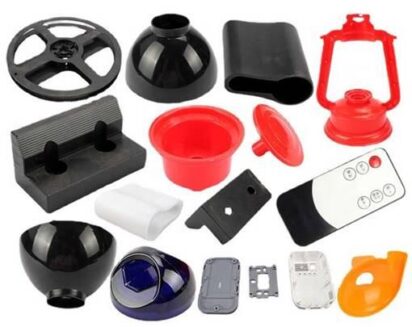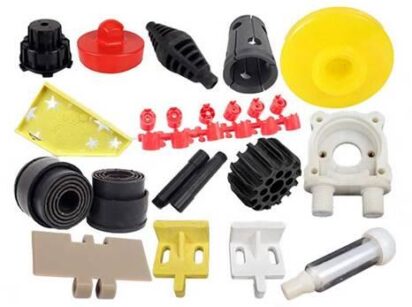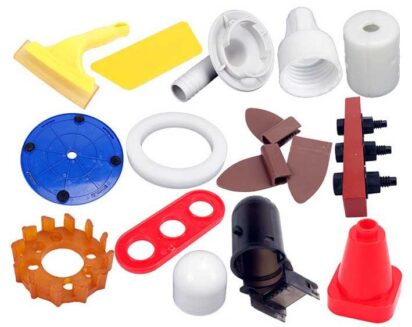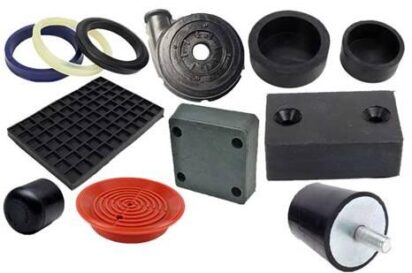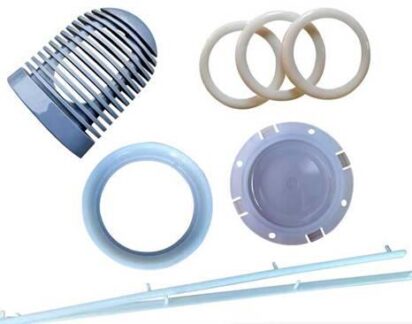What are plastic parts? The manufacturing process of precision plastic parts.
The choice of plastic part is mainly determined by the type of plastic (thermoplastic or thermoset), the starting form, and the shape and size of the part. The production of injection molded parts generally adopts compression molding, transfer molding, and injection molding. Lamination, molding and thermoforming are the shaping of plastics over molds. The above methods can be used in rubber processing. Navíc, there are castings using liquid monomers or polymers as raw materials. Among these methods, extrusion and injection molding are the most widely used and the most basic molding methods.
Injection molded parts refer to various injection molded products produced by injection molding machines, collectively referred to as injection molded parts. It is mainly made of materials such as polyethylene or polypropylene with various organic solvents added.
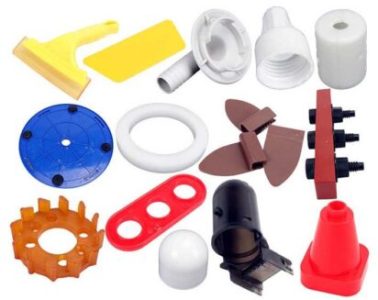
Injection molded nylon parts
The main characteristics of plastic parts
Most plastic parts are light in weight, chemically stable, and will not rust;
Good impact resistance of plastic parts;
Plastic parts have good transparency and wear resistance;
Plastic parts have good insulation and low thermal conductivity;
Plastic parts generally have good formability and colorability, and low processing cost;
Most plastic parts have poor heat resistance, high thermal expansion rate, and are easy to burn;
Plastic parts have poor dimensional stability and are easily deformed;
Most plastics have poor low temperature resistance, become brittle at low temperature, and are easy to age;
Certain plastics are easily soluble in solvents.
Plastic parts can be divided into thermosetting and thermoplastic. The former cannot be reshaped and used, while the latter can be reproduced. Thermoplasticity has a large physical elongation rate, generally 50% to 500%. The force does not vary perfectly linearly at different elongations.
The different properties of plastics determine its use in life and industry. With the advancement of technology, research on plastic modification has never stopped. It is hoped that in the near future, modified plastics can be used more widely, and even replace steel and other materials without polluting the environment.
Molecular structure of plastic parts
There are basically two types: the first is a linear structure, and polymers with this structure are called linear polymers. The second type is the body structure, and the polymer compound with this structure is called the body polymer compound. Some polymers have branched chains, called branched polymers, which are linear structures. Although some polymers have cross-links between molecules, they are less cross-linked, which is called a network structure and belongs to a body structure.
Two different structures exhibit two opposite properties. Linear structure, heating can melt, less hardness and brittleness. The body structure is relatively hard and brittle. Plastics have two structures of polymers, thermoplastics made of linear polymers, and thermosetting plastics made of body-shaped polymers.
Material properties of plastic parts
〈1〉Chemical corrosion resistance
<2> glossy, partially transparent or translucent
<3> Most of them are good insulators
〈4〉Light and strong
〈5〉It is easy to process and can be produced in large quantities, and the price is cheap
〈6〉 Wide range of uses, multi-purpose, easy to color, partly resistant to high temperature
Manufacturing process of injection molded parts
The main process parameters of injection molded parts include:
1. Cylinder temperature: Melt temperature is very important, and the temperature of the injection cylinder used is only a guideline. Melt temperature can be measured at the nozzle or using the air jet method. The temperature setting of the injection cylinder depends on the melt temperature, screw speed, back pressure, injection volume and injection cycle. If you do not have experience with a particular grade of plastic, start with the lowest setting. For ease of control, the firing cylinders are divided into zones, but not all are set to the same temperature. If operating for a long time or at high temperature, please set the temperature of the first zone to a lower value, which will prevent the plastic from melting and shunting prematurely. Make sure the hydraulic oil, hopper closure, mold, and injection cylinder are at the correct temperature before starting to mold your part.
2. Melt temperature: The melt temperature plays a major role in the flow properties of the melt. Since plastics do not have a specific melting point, the so-called melting point is a temperature range in a molten state. The structure and composition of plastic molecular chains are different, so the impact on their fluidity is also different. Rigid molecular chains are obviously affected by temperature, such as PC, PPS, atd. However, the fluidity of flexible molecular chains such as PA, PP, PE, atd. is not obvious by changing the temperature, so the reasonable temperature of injection molded parts should be adjusted according to different materials.
3. Mold temperature: Due to the high crystallization temperature and slow crystallization speed of some plastic materials, higher mold temperature is required. Some require higher or lower temperatures due to size and deformation control, or the need for demoulding. For example, PC generally requires more than 60°C, while PPS sometimes needs mold temperature above 160°C in order to achieve better appearance and improve fluidity. Proto, the mold temperature has an inestimable effect on improving the appearance, deformation, size and rubber mold of the product.
4. Injection pressure: The melt overcomes the resistance required to advance, which directly affects the size, weight and deformation of the product. Different plastic products require different injection pressures. For materials such as PA and PP, increasing the pressure will significantly improve their fluidity. The injection pressure determines the density of the product, that is, the appearance gloss. It has no fixed value, and the more difficult it is to fill the mold, the greater the pressure of the injection molded part.
Disadvantages of plastic parts
1. When recycling waste plastic parts, sorting is very difficult and economically uneconomical.
2. Plastic parts are easy to burn and produce toxic gas when burned. For example, toluene is produced when polystyrene is burned. A small amount of this substance can cause blindness, and symptoms such as vomiting if inhaled. The burning of PVC will also produce toxic hydrogen chloride gas. In addition to burning, it is a high-temperature environment, which will cause the plastic to decompose and produce toxic components, such as benzene.
3. Plastics are made from petroleum refining products, and petroleum resources are limited.
4. It takes hundreds of years for plastic to rot in the ground.
5. The heat resistance of plastic is poor, and it is easy to age.
6. Due to the non-natural degradability of plastic, it has become the No. 1 enemy of human beings, and it has also caused the death of many animals. For example, monkeys, pelicans, dolphins and other animals in the zoo will accidentally swallow the No. 1 plastic bottle thrown away by tourists, and finally die painfully due to indigestion. Looking at the beautiful and pure sea, and looking closer, it is actually full of all kinds of plastic waste that cannot be accommodated by the ocean. Various indigestible plastics were found in the intestines of several dead seabird samples.
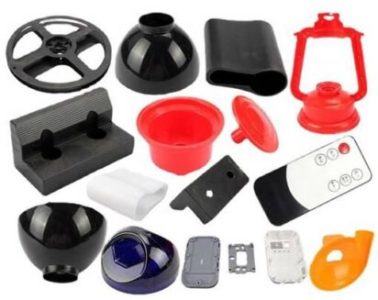 plastic parts manufacturer |
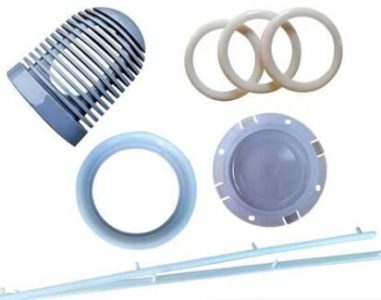 ABS lamp plastic shell |
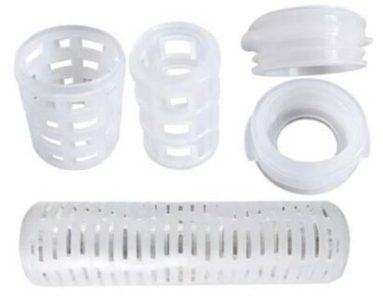 PP plastic parts for filter |
Overview of Plastic Part Types
Plastic raw material is defined as a synthetic or natural high molecular polymer. It can be arbitrarily kneaded into various shapes, and finally can keep the shape of the material or plastic material product.
| type of plastic | |||||
| scientific name | Abbreviation | Chinese name | commonly known as | recycling symbol | use |
| Polyethylene | PE | polyethylene | low temperature items | ||
| Polypropylene | PP | Polypropylene | pleated glue, plast | 05 | Microwave lunch box, can be used at around 100°C |
| High Density Polyethylene | HDPE | high density polyethylene | Hard and soft glue | 02 | Cleaning supplies, bath products |
| Low Density Polyethylene | LDPE | low density polyethylene | 04 | Cling film, plastic film, atd. | |
| Linear Low Density Polyethylene | LLDPE | linear low density polyethylene | |||
| Polyvinyl Chloride | PVC | PVC | Vinyl | 03 | rarely used in food packaging |
| General Purpose Polystyrene | GPPS | General grade polystyrene | hard glue | ||
| Expansible Polystyrene | EPS | polystyrene foam | Styrofoam | ||
| High Impact Polystyrene | HIPS | Impact-resistant polystyrene | Impact-resistant hard rubber | ||
| Styrene-Acrylonitrile Copolymers | AS,SAN | Styrene-acrylonitrile copolymer | clear glue | ||
| Acrylonitrile-Butadiene-Styrene Copolymers | ABS | Acrylonitrile-butadiene-styrene copolymer | super glue | ||
| Polymethyl Methacrylate | PMMA | polymethacrylate | Acrylic plexiglass |
||
| Ethylene-Vinyl AcetateCopolymers | EVA | Ethylene-vinyl acetate copolymer | rubber | ||
| Polyethylene Terephthalate | PET | polyethylene terephthalate | polyester | 01 | Mineral water bottle, carbonated drink bottle |
| Polybutylene Terephthalate | PBT | polybutylene terephthalate | |||
| Polyamide (Nylon 6.66) | PA | polyamide | nylon | ||
| Polycarbonates | PC | polycarbonate | bulletproof glue | 07 | Kettles, cups, bottles |
| Polyacetal | POM | Polyacetal | Saigang, Duracan | ||
| Polyphenylene oxide | PPO | polyphenylene ether | Noryl | ||
| Polyphenylene sulfide | PPS | polyphenylene sulfide | Polyphenylene sulfide | ||
| Polyurethanes | PU | polyurethane | Polyurethane | ||
| Polystyrene | PS | polystyrene | 06 | Bowl of instant noodles box, fast food box | |
| Poly tetra fluoroethylene | PTFE | PTFE | Teflon, Teflon | ||
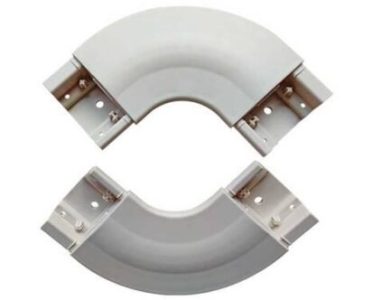 ABS plastic parts for cars |
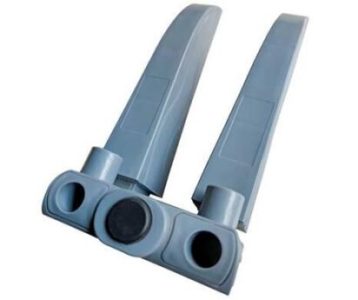 Plastic parts for daily necessities |
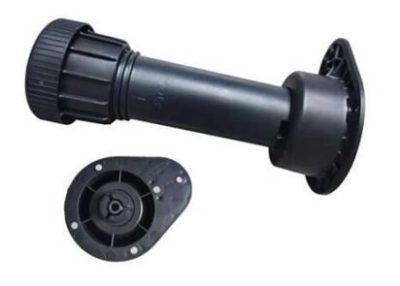 ABS injection molded parts for table and chair legs |
Plastic is an important organic synthetic polymer material with a wide range of applications. But the “white pollution” caused by discarded plastics is becoming more and more serious. If we can understand the composition and classification of plastics in detail, it will not only help us use plastic products scientifically, but also facilitate the sorting and recycling of plastics, and effectively control and reduce “white pollution”.
transparent small acrylic puzzle plastic parts, board game interlocking beach chess mosaic plastic parts, meccano toy shogi backgammon large plastic parts, food corner solid mask full plastic parts, kitchen pan filled head plastic parts.
Manufacturing process of plastic products
Compression molding of plastic parts
Compression molding, also known as compression molding, is a molding method in which the molding compound is pressurized (generally heated) in a closed cavity.
Lamination of plastic parts
A method of combining two or more layers of the same or different materials into a whole by heating and pressure with or without an adhesive.
Cold molding of plastic parts
Cold press molding is also called cold press sintering molding. The difference from ordinary compression molding is that the material is pressurized and molded at room temperature.
Transfer molding of plastic parts
Transfer molding is a molding method of thermosetting plastics. When molding, the molding compound is heated and softened in a heating chamber, and then pressed into the heated cavity to solidify and form.
Extrusion of plastic parts
Extrusion molding is also called extrusion molding or extrusion molding. It is a method in which plastic materials are continuously molded through a die in a flowing state by heating and pressurizing in an extruder.
Extrusion and pultrusion of plastic parts
Pultrusion molding is one of the molding methods of thermosetting fiber reinforced plastics. It is used to produce profiles with fixed section shape and unlimited length.
Injection molding of plastic parts
Injection molding (injection molding) is a method in which a thermoplastic or thermosetting molding compound is uniformly plasticized in a heated barrel and then pushed into the cavity of a closed mold by a plunger or moving screw.
blow molding
A method in which the hot parison closed in the mold is inflated into a hollow product by gas pressure, or the tube parison is blown into a tube film without a mold.
Casting of plastic parts
The method of injecting liquid monomer, resin or its mixture into the mold and making it into a solid product without pressurization or slight pressurization.
Hand lay-up of plastic parts
Hand lay-up molding, also known as hand-pasted molding and contact molding, is one of the methods for manufacturing reinforced plastic products.
Filament winding molding of plastic parts
Under the conditions of controlled tension and predetermined line type, the continuous wire impregnated with resin glue is wound onto the mandrel or mold to form reinforced plastic products.
Calendering of plastic parts
A molding method that passes thermoplastics through a series of heated rollers to form a film or sheet under the action of extrusion and stretching.
Coating of plastic parts
For the purposes of anti-corrosion, insulation, decoration, atd., a method of coating a thin layer of plastic (eg, less than 0.3 mm) on the surface of fabrics, paper, metal foils, or boards in liquid or powder form.
Foam molding of plastic parts
Foam molding is the process of creating a microcellular structure in plastics. Almost all thermosetting and thermoplastic plastics can be made into foam plastics. Commonly used resins are polystyrene, polyurethane, polyvinyl chloride, polyethylene, urea-formaldehyde, phenolic and so on.
Secondary molding of plastic parts
Overmolding is one of the methods of plastic molding processing. A method of using plastic profiles or parisons as raw materials to make them into products of the desired shape through heating and external force.
 Shaped parts of rubber |
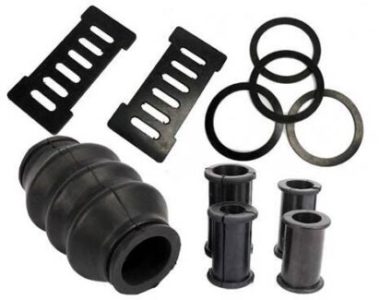 Injection molded parts of rubber products |
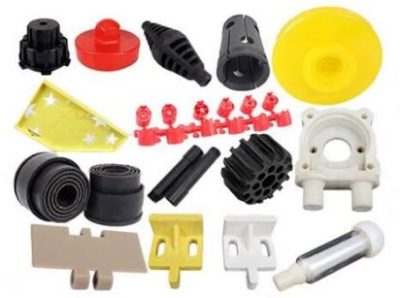 pp/pe/pom/abs injection parts |
| main products | Precision molds, injection molds, extrusion molds, injection products, casting molds, blow molds, atd. 88T, 90T, 120T, 168T, 200T, 250T, 380T, 420T, 600T, 800T, 1000T, 1200T, 1500T, 2200T, 2800T, 3000T |
|
| 2 | Injection molding equipment (two-color injection molding machine) | 88T,90T,120T,168T,200T,250T,380T,420T,600T,800T,1000T,1200T,1500T,2200T,2800T,3000T |
| 3 | Application field | Electronics industry, medical industry, home appliance industry, aerospace, shipbuilding, household goods, automobile industry, semiconductor industry, food processing, robot industry, military průmysl, atd. |
| 4 | formwork standard | LKM standard (Long Kee), DME standard, HASCO standard (Europe and America), Fudeba standard (Japan), Enzi company custom standard, atd. |
| 5 | Die steel material | 718H/738H/718/738/NAK80/S136/S136H/2738/2316/H13/P20/2344ESR/8407/SKD-61…… |
| 6 | Mold precision | +/-0.01mm |
| 7 | Die life | 100,000-1 million modules |
| 8 | mold cavity | single chamber, multi-chamber |
| 9 | Mold runner | Hot runner and cold runner |
| 10 | Mold processing equipment | Enqi company has: imported CNC center, EDM electric discharge machine, imported mirror spark machine, high-speed engraving machine, laser cutting machine, Sodick slow wire walking machine, precision grinding machine, precision plastic injection molding machine, two-color injection molding machine, atd. |
| 11 | plastic raw material | Nylon6, Nylon66, PA6, PA66, PA6+GF, ABS, ABS+GF, ABS+PC, POM(Derlin), PP, PE, PC, PVC,PPO,PBT,PET,PMMA(Acrylic),TPU,EPDM,NBR, Silicon,UHMWPE,PVDF,PTFE,ETFE,PFA,PCTFE,FEP,PVF,PSF, PEI, PSU,PPSU, PPS, PEEK, PAI, PI, PBI,atd. |
| 12 | barva | White, černý, gray, green, blue, pink, yellow, gold, natural color and other custom colors |
| 13 | Surface treatment process | Polishing, painting, electroplating, anodizing, brushing, silk screen printing, water transfer printing, leather covering, texture, sandblasting, bronzing, UV painting, atd. |
| 14 | Product drawings | 2D diagram, 3D diagram, sample or multi-angle picture size |
| 15 | delivery period | Injection mold manufacturing takes 20-30 working days, and the delivery time of injection molded products depends on the quantity |
| 16 | quality system | ISO 9001, RoHS standard, FDA standard, atd. |
 English
English العربية
العربية Български
Български 中文(漢字)
中文(漢字) Čeština
Čeština Dansk
Dansk Eesti keel
Eesti keel Suomi
Suomi Français
Français Deutsch
Deutsch Ελληνικά
Ελληνικά עברית
עברית Magyar
Magyar Bahasa Indonesia
Bahasa Indonesia Italiano
Italiano 日本語
日本語 한국어
한국어 Latīna
Latīna Latviešu valoda
Latviešu valoda Lëtzebuergesch
Lëtzebuergesch Polski
Polski Português
Português Română
Română Русский
Русский Slovenščina
Slovenščina Español
Español Svenska
Svenska ภาษาไทย
ภาษาไทย Tiếng Việt
Tiếng Việt
